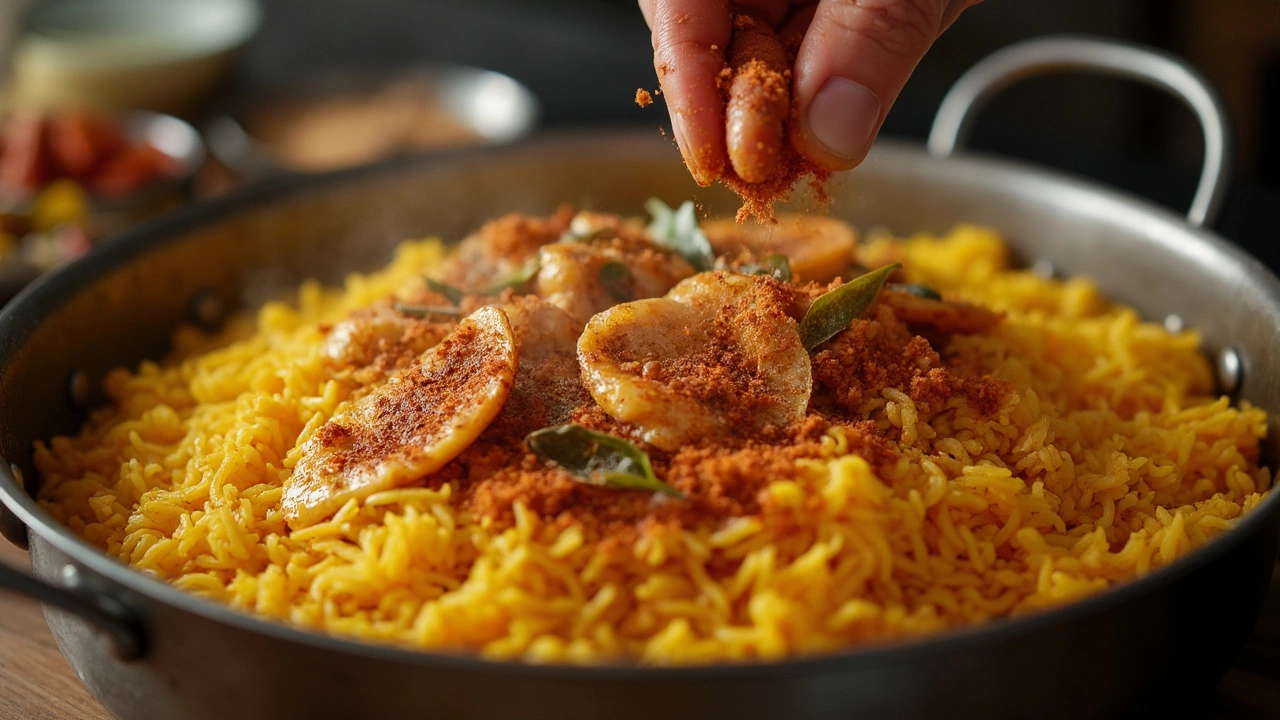Biryani doesn’t have to set your mouth on fire—unless you want it to. Getting that perfect balance of spice is all about understanding what goes in and how it blends together, not just loading up on chilies. You can still get deep, mouthwatering flavors without having to gulp down a jug of water after every bite.
Start by knowing your spices. Not all chili powders or green chilies are created equal. Kashmiri red chili powder, for example, gives color without much heat, while fresh bird’s eye chilies bring pure fire. Mixing these up is a rookie mistake that can leave your biryani way too hot.
If you love bold flavors but not eye-watering heat, remember you can always add more spice—but you can’t take it out. So, go slow. Taste as you go, and don’t trust the recipe blindly. Even grandma had to tweak her masala now and then.
- Why Biryani Gets Too Spicy
- Choosing and Using Spices Correctly
- Fixing Biryani That’s Too Hot
- Tips for Consistent Flavor Every Time
Why Biryani Gets Too Spicy
Sometimes, a tasty biryani turns out way spicier than planned. So, what’s going on? First off, the type and amount of chilies make a huge difference. Red chili powder, especially the regular hot variety, packs real heat, while green chilies (like the small Indian ones) can be shockingly spicy even in tiny amounts.
A common slip-up is using more than one kind of chili at once—maybe fresh chilies, chili powder, and a ‘spicy’ biryani masala blend together. The heat doesn’t just add up; it multiplies. Every brand of spice can also vary in strength. One tablespoon of chili powder from one brand might be mild, while the same amount from another could leave you sweating.
Another factor is how long you cook the biryani. Spices release more heat as they simmer. If you throw in all your spicy ingredients early and cook them down, the whole dish absorbs and intensifies the heat.
- Layering mistakes: Spices dumped in one spot means some bites are super spicy while others are bland.
- Pre-made spice mixes: These are unpredictable. They’re often designed for one-pot recipes and can sneak in loads of chili powder.
- Ignoring guests’ tolerance: What’s mild for you might be way too much for someone else. South Indian-style biryani tends to be hotter than North Indian versions.
Even the kind of rice you use can matter. Basmati rice soaks up more flavor and spice, while cheaper short-grain rice sometimes can’t handle the heat and makes the whole thing uneven.
| Common Reasons for Spicy Biryani | Likelihood |
|---|---|
| Too much or mixed chili | Very Common |
| Overcooking with spices | Common |
| Unfamiliar masala blends | Moderately Common |
| No taste testing | Very Common |
If you figure out which of these tripped you up last time, you’re already halfway to fixing it for the next batch of biryani.
Choosing and Using Spices Correctly
Getting the spice level right in biryani starts in your spice box. Not all spices are created equal, so a small change can tip the balance. Biryani calls for a mix that makes it flavorful, not just spicy. There’s a reason classic recipes use whole spices like cinnamon sticks, cloves, cardamom, and bay leaves along with ground spices. The whole ones give aroma and warmth, while the powders add punch.
If you’re new to making biryani, the big question is always, “How much chili powder or fresh chili should I use?” Here’s where you can cheat a little. Use Kashmiri red chili powder for color and mild flavor, and reserve the stronger stuff like bird’s eye chilies if you know your crowd can handle serious heat. In fact, a lot of restaurant biryanis look super red but aren’t that hot — that’s Kashmiri chili at work.
| Spice Type | Flavor | Heat Level |
|---|---|---|
| Kashmiri Chili Powder | Rich color, mild | Low |
| Bird's Eye Chili | Hot, sharp | Very High |
| Black Pepper | Earthy, pungent | Moderate |
| Green Cardamom | Slightly sweet, citrusy | None |
Always bloom your ground spices in oil or ghee before mixing in rice or meat. It wakes up the flavors and dials down the harshness of the raw spices. Don’t just toss everything in at once. Following the steps as written actually helps the flavors get deeper, not just hotter.
Start with less than what the recipe says, especially if you’re using a brand of chili powder or garam masala you haven’t tried before. Spice strength varies a lot between brands and batches, so what works in one kitchen can blow your head off in another.
- Measure your chili powders—don’t eyeball it.
- Always go mild for the first batch and adjust for your next one.
- Taste the biryani masala before adding rice; it’s easier to change the spice now than later.
Lastly, cloves, cinnamon, and cardamom can make biryani taste strong even if it’s not hot. If your family isn’t into strong whole spice flavors, fish those pieces out before serving. It’s a simple touch but it can really help keep things balanced.

Fixing Biryani That’s Too Hot
So, you got carried away with the chili powder, and now your biryani has turned into a daredevil’s food challenge. Don’t panic—there are easy ways to cool things down without making the whole batch go to waste. Plenty of home cooks face this problem, especially with strong Indian recipes where the heat creeps up quickly.
- Add Dairy: A dollop of yogurt or a splash of cream can mellow the heat instantly. Dairy binds to spicy compounds and tones down the burn. Stir in cool, plain yogurt when fluffing up the rice—don’t worry, it won’t make it soggy if you use just enough.
- Mix in More Rice: If there’s way too much heat, cook a fresh batch of plain rice and mix it in. This increases the volume, spreading the spice over a bigger area, which makes each bite less intense.
- Use Potatoes: Drop a few peeled, raw potato chunks into the pot while reheating. They soak up some of the spiciness. Just remember to remove them before serving—they’ll taste spicy but take the edge off the main dish.
- Squeeze in Some Lemon Juice: Acidic ingredients like lemon juice can take the bite out of strong flavors. Just a couple of squeezes, and you’ll notice the flavor balance gets much better.
- Serve With Cooling Sides: Pair your fiery biryani with raita, a cucumber yogurt salad, or even simple sliced cucumbers. They give your mouth a break and help control the heat with every spoonful.
Here’s a quick comparison of what works best, based on average home cooking experiences:
| Fix | Best For | How Quick? |
|---|---|---|
| Add yogurt/cream | Instantly lowering heat | Immediate |
| Mix more rice | Large, extra-spicy batches | 5–10 minutes |
| Potatoes | Mild cases, reheating stage | 10–15 minutes |
| Lemon juice | Refreshing the taste | Immediate |
| Cooling sides | Serving time | Immediate |
Don’t try to “fix” biryani by just adding water—it makes it soggy and dulls all the flavors, not just the spicy ones. Stick with ingredients that busy kitchens actually use for cooking tips and you’ll rescue your biryani without losing its character.
Tips for Consistent Flavor Every Time
If your biryani sometimes hits the spot and other times lands way off, you’re not alone. Nailing that consistent spice level and flavor every single time can feel tricky, but it’s actually about finding a rhythm and sticking to a few basic habits in the kitchen.
- Use Measuring Spoons: "Eyeballing" your spices can work, but it’s super unreliable, especially if you’re cooking for a crowd. Use proper teaspoons and tablespoons. Track exactly how much of each spice goes in and jot it down for next time.
- Check Your Spices’ Strength: Spices lose flavor fast—whole spices last longer than powders. If your ground cumin or chili powder is older than 6 months, it could be messing with your expected taste. Label jars when you buy them.
- Combine Wet and Dry Masalas Right: Always sauté onions, ginger, garlic, and your whole spices properly before adding meat or rice. This step wraps flavor around each grain and keeps tastes even throughout.
- Layer Carefully: Dumping all your Indian recipes spices in one go can lead to uneven bites. When you layer rice and masala, try sprinkling a small amount of garam masala or fried onions on each layer so you don’t end up with a flavor bomb just on top.
- Keep a Test Spoon: Taste before sealing the biryani pot. If you think it lacks punch, add a pinch more of the main spice (like garam masala or chili powder)—but mix gently to keep the rice pristine.
Want to compare how spice levels change with different kinds of chili? Here’s a handy chart that many home cooks find helpful:
| Chili Type | Heat Level (Scoville Units) | Common Use |
|---|---|---|
| Kashmiri Chili | 1,000 - 2,000 | Color, mild heat |
| Byadgi Chili | 8,000 - 15,000 | Rich flavor, moderate heat |
| Bird's Eye Chili | 50,000 - 100,000 | Very spicy, sharp |
The more you repeat the same method, the more your hands and eyes know exactly what works. Save the basics in your phone’s notes app or a kitchen diary, especially when making tweaks. This way, your biryani comes out tasty every time, no matter who’s coming to dinner.
